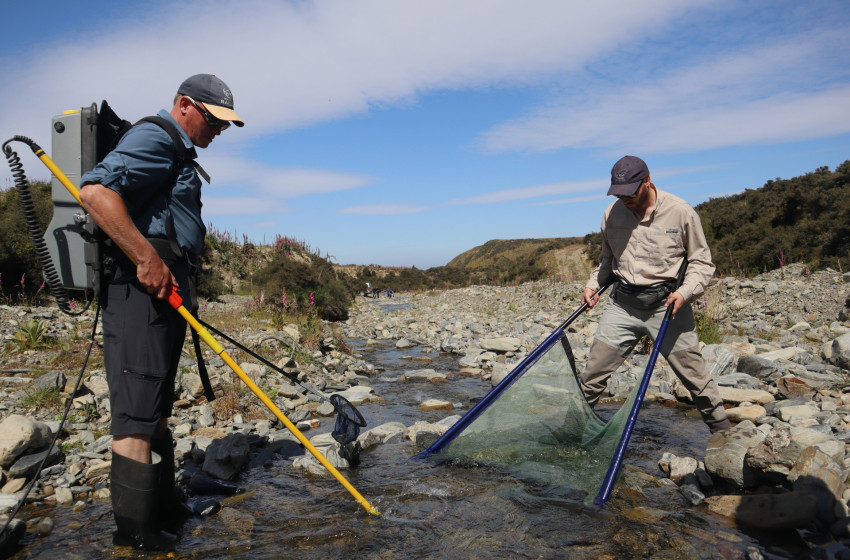Fish & Game and ORC team up for brook trout relocation
- Otago
- 18/12/2023

Pictured: Otago Fish & Game officers Ben Sowry (left) and Mason Court electric-fish Pisgah Creek. Photo: Bruce Quirey, Otago Fish & Game
Brook trout were last week removed from Pisgah Creek, giving threatened native galaxiids an increased chance to boost their numbers.
Kye Burn farmers, staff from Otago Regional Council and the Otago Fish and Game Council carried out the trout translocation from Pisgah Creek, a tributary of the Kye Burn to the east of Ranfurly township, using a fish transportation unit.
The trout were relocated to Coalpit Dam where the species is already present in low numbers. The work is part of a combined effort to protect numerous galaxiid species across Otago from eventual extinction while maintaining healthy sports fisheries.
Increased protection . . .a Central Otago round head galaxiid in Pisgah Creek today
Otago Fish & Game chief executive Ian Hadland says the organisation supports the conservation of these important species.
"This is one of a small number of places in Otago where it’s necessary to intervene to separate predators from the galaxiid population," Mr Hadland says.
"Translocating the trout away from sensitive galaxiid populations is an act of balancing both protection of rare native species and preserving a unique species of sports fish which anglers enjoy catching."
"Galaxiid species in Otago face threats on many fronts, including predation and habitat competition from salmonid, native predators such as eels, water abstraction, mechanical clearing of waterways and the discharge of contaminants.
"Fish & Game wants to see the issues addressed as a whole to ensure the long-term survival of threatened species."
Mr Hadland says brook trout are relatively rare across Otago but are prolific in the streams they do occupy.
"Fish & Game has no intention to let them spread their present range further, but supporting current populations in accessible locations where they already exist is something our licence holders expect of us."
The dwindling galaxiid populations, especially those fish which are non-migratory and otherwise live entirely within only a few hundred metres of some streams, are most at risk, says ORC’s Team Leader Biodiversity, Pete Ravenscroft.
"Otago’s galaxiid population are fragmented and are continuing to disappear; without active management, including the removal of predators, their slide towards extinction will continue, so this is a good first step," he says.
"We welcome the support of staff of Fish & Game, particularly their expertise in electric fishing and trout transfers. It's good to see the trout going to places where they will be available to anglers rather than being simply euthanised on site."
ORC, with the support of the Kye Burn farmers, have removal programmes in place within four tributaries including the recently opened galaxiid sanctuary in Spec Creek.
Mr Ravenscroft says to undertake this removal work a special licence was obtained from Otago Fish and Game.
On the move . . . Otago Fish and Game Officer - Trout Hatchery Manager, Steve Dixon, with brook trout being removed from Pisgah Creek (in background) today, before transporting to Coalpit Dam, near Naseby.
ORC, alongside stakeholders including Fish and Game, is currently writing a five-year plan which will prioritise species and populations.
"We need a better understanding of the current state of Otago non-migratory galaxiids and sports fish before we can finalise the plan. The understanding of the mechanisms that are currently protecting the galaxiids from threats will provide the knowledge to make this plan fit for purpose.
"Once it is finalised and resources are confirmed, ORC will be better placed to confirm what restoration projects will be next," Mr Ravenscroft says.